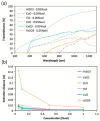Nanofluids for Direct-Absorption Solar Collectors-DASCs: A Review on Recent Progress and Future Perspectives
- PMID: 37049324
- PMCID: PMC10096558
- DOI: 10.3390/nano13071232
Nanofluids for Direct-Absorption Solar Collectors-DASCs: A Review on Recent Progress and Future Perspectives
Abstract
Owing to their superior optical and thermal properties over conventional fluids, nanofluids represent an innovative approach for use as working fluids in direct-absorption solar collectors for efficient solar-to-thermal energy conversion. The application of nanofluids in direct-absorption solar collectors demands high-performance solar thermal nanofluids that exhibit exceptional physical and chemical stability over long periods and under a variety of operating, fluid dynamics, and temperature conditions. In this review, we discuss recent developments in the field of nanofluids utilized in direct-absorption solar collectors in terms of their preparation techniques, optical behaviours, solar thermal energy conversion performance, as well as their physical and thermal stability, along with the experimental setups and calculation approaches used. We also highlight the challenges associated with the practical implementation of nanofluid-based direct-absorption solar collectors and offer suggestions and an outlook for the future.
Keywords: direct-absorption solar collectors; nanofluids; solar thermal energy conversion.
Conflict of interest statement
The authors declare no conflict of interest.
Figures













Similar articles
-
Nanofluid Types, Their Synthesis, Properties and Incorporation in Direct Solar Thermal Collectors: A Review.Nanomaterials (Basel). 2017 May 31;7(6):131. doi: 10.3390/nano7060131. Nanomaterials (Basel). 2017. PMID: 28561802 Free PMC article. Review.
-
A Review on Recent Progress in Preparation of Medium-Temperature Solar-Thermal Nanofluids with Stable Dispersion.Nanomaterials (Basel). 2023 Apr 18;13(8):1399. doi: 10.3390/nano13081399. Nanomaterials (Basel). 2023. PMID: 37110985 Free PMC article. Review.
-
Application of Few-Layered Reduced Graphene Oxide Nanofluid as a Working Fluid for Direct Absorption Solar Collectors.J Nanosci Nanotechnol. 2017 Feb;17(2):1233-239. doi: 10.1166/jnn.2017.12695. J Nanosci Nanotechnol. 2017. PMID: 29683297
-
Carbon-Nanohorn Based Nanofluids for a Direct Absorption Solar Collector for Civil Application.J Nanosci Nanotechnol. 2015 May;15(5):3488-95. doi: 10.1166/jnn.2015.9837. J Nanosci Nanotechnol. 2015. PMID: 26504968
-
Experimental Exploration of Hybrid Nanofluids as Energy-Efficient Fluids in Solar and Thermal Energy Storage Applications.Nanomaterials (Basel). 2023 Jan 9;13(2):278. doi: 10.3390/nano13020278. Nanomaterials (Basel). 2023. PMID: 36678031 Free PMC article. Review.
Cited by
-
Progress on Material Design and Device Fabrication via Coupling Photothermal Effect with Thermoelectric Effect.Materials (Basel). 2024 Jul 16;17(14):3524. doi: 10.3390/ma17143524. Materials (Basel). 2024. PMID: 39063816 Free PMC article. Review.
-
The Role of Nanofluids in Renewable Energy Engineering.Nanomaterials (Basel). 2023 Sep 29;13(19):2671. doi: 10.3390/nano13192671. Nanomaterials (Basel). 2023. PMID: 37836312 Free PMC article.
References
-
- Alper A., Oguz O. The role of renewable energy consumption in economic growth: Evidence from asymmetric causality. Renew. Sustain. Energy Rev. 2016;60:953–959. doi: 10.1016/j.rser.2016.01.123. - DOI
-
- Ohler A., Fetters I. The causal relationship between renewable electricity generation and GDP growth: A study of energy sources. Energy Econ. 2014;43:125–139. doi: 10.1016/j.eneco.2014.02.009. - DOI
-
- IEA . World Energy Outlook 2017. IEA; Paris, France: 2017.
-
- Kabir E., Kumar P., Kumar S., Adelodun A.A., Kim K.-H. Solar energy: Potential and future prospects. Renew. Sustain. Energy Rev. 2018;82:894–900. doi: 10.1016/j.rser.2017.09.094. - DOI
-
- Conti J., Holtberg P., Diefenderfer J., LaRose A., Turnure J.T., Westfall L. International Energy Outlook 2016 with Projections to 2040. USDOE Energy Information Administration (EIA); Washington, DC, USA: 2016.
Publication types
Grants and funding
LinkOut - more resources
Full Text Sources

